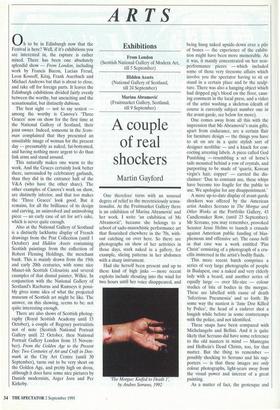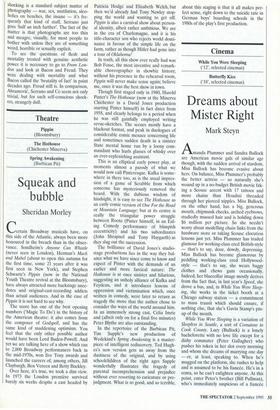ARTS
Exhibitions
From London (Scottish National Gallery of Modern Art, till 5 September) Hidden Assets (National Gallery of Scotland, till 24 September) Marina Abramovie (Fruitmarket Gallery, Scotland, till 9 September)
A couple of real shockers
Martin Gayford
h to be in Edinburgh now that the Festival is here? Well, if it's exhibitions you are interested in, the rapture is rather mixed. There has been one absolutely splendid show — From London, including work by Francis Bacon, Lucian Freud, Leon Kossoff, Kitaj, Frank Auerbach and Michael Andrews but that is about to close, and take off for foreign parts. It leaves the Edinburgh exhibitions divided fairly evenly between the worthy, but unexciting and the sensationalist, but distinctly dubious.
The best sight — not to say sexiest — among the worthy is Canova's 'Three Graces' now on show for the first time at the National Gallery of Scotland, their joint owner. Indeed, someone in the Scots- man complained that they presented an unsuitable image of woman for the present day — presumably as naked, fat-bottomed, and having nothing more urgent to do than link arms and stand around.
This naturally makes one warm to the work. And the Graces certainly look better there, surrounded by celebratory garlands, than they did in the entrance hall of the V&A (who have the other share). The other examples of Canova's work on show, are distinctly inferior, and that too makes the 'Three Graces' look good. But it remains, for all the brilliance of its design and carving, an uninvolved and uninvolving piece — an early case of art for art's sake, which is never quite enough.
Also at the National Gallery of Scotland is a distinctly lacklustre display of French drawings from the Prat Collection (until 1 October) and Hidden Assets containing Scottish paintings from the collection of Robert Fleming Holdings, the merchant bank. This is mainly drawn from the 19th and early 20th centuries, with some nice Manet-ish Scottish Colourists and several examples of that dismal painter, Wilkie. In conjunction with the National Gallery of Scotland's Raeburns and Ramseys it possi- bly gives some idea of what the projected museum of Scottish art might be like. The answer, on this showing, seems to he: not quite interesting enough.
There are also shows of Scottish photog- raphy (Royal Scottish Academy until 15 October), a couple of Regency portraitists not of note (Scottish National Portrait Gallery until 22 October, then National Portrait Gallery London from 15 Novem- ber). From the Golden Age to the Present Day: Two Centuries of Art and Craft in Den- mark at the City Art Centre (until 30 September), turns out to be very short on the Golden Age, and pretty high on dross, although it does have some nice pictures by Danish modernists, Asger Jorn and Per Kirkeby. One therefore turns with an unusual degree of relief to the meretriciously sensa- tionalist. At the Fruitmarket Gallery there is an exhibition of Marina Abramovid and her work. I write 'an exhibition of Ms Abramovid', because she belongs to a school of sado-masochistic performance art that flourished elsewhere in the 70s, with- out catching on over here. So there are photographs on show of her activities in those days, stark naked in a gallery, for example, slicing patterns in her abdomen with a sharp instrument.
Had she herself been present and up to these kind of high jinks — more recent exploits include shouting into the wind for two hours until her voice disappeared, and The Morgue: Knifed to Death 1', by Andres Serrano, 1992 being hung naked upside-down over a pile of bones — the experience of the exhibi- tion might have been more memorable. As it was, it mainly concentrated on her non- performance pieces — which included some of those very tiresome affairs which involve you the spectator having to sit or stand in a certain place and be the sculp- ture. There was also a hanging object which had dripped pig's blood on the floor, caus- ing comment in the local press, and a video of the artist washing a skeleton (death of course is currently subject number one in the avant-garde, see below for more).
One comes away from all this with the impression that Ms Abramovid's main gifts, apart from endurance, are a certain flair for furniture design — the things you have to sit on are in a quite stylish sort of designer neolithic — and a knack for con- cocting arresting labels. A piece called God Punishing — resembling a set of horse's tails mounted behind a row of crystals, and purporting to be made of 'quartz, Korean virgin's hair, copper' — carried the dis- claimer: 'Due to constant use, these whips have become too fragile for the public to use. We apologise for any disappointment.'
A more up-to-date display of avant-garde shockers was offered by the American artist Andres Serrano in The Morgue and Other Works at the Portfolio Gallery, 43 Candlemaker Row, (until 23 September). Mr Serrano, you may remember, provoked Senator Jesse Helms to launch a crusade against American public funding of blas- phemous and offensive art. The casus belli in that case was a work entitled 'Piss Christ' consisting of a photograph of a cru- cifix immersed in the artist's bodily fluids.
This more recent batch comprises a series of very large photographs of people in Budapest, one a naked and very elderly lady with a beard, and another series of equally large — over life-size — colour studies of bits of bodies in the morgue. These are labelled with cause of death 'Infectious Pneumonia' and so forth. By some way the nastiest is 'Jane Doe Killed by Police', the head of a cadaver shot a longish while before in some contretemps with the police, and not identified.
These snaps have been compared with Michelangelo and Bellini. And it is quite likely that Serrano did have some reference to the old masters in mind — Mantegna and Holbein's Dead Christs, too, for that matter. But the thing to remember — possibly shocking to Serrano and his sup- porters — is that these images are only colour photographs, light-years away from the visual power and interest of a great painting.
As a matter of fact, the grotesque and shocking is a standard subject matter of Photography — war, sex, mutilation, alco- holics on benches, the insane — it's fre- quently that kind of stuff, Serrano just goes 'half an inch further'. The fact of the matter is that photographs are too thin and meagre, visually, for most people to bother with unless they are of something weird, horrible or sexually explicit.
To see the questions of flesh and mortality treated with genuine aesthetic power it is necessary to go to From Lon- don and look at Bacon and Freud. They were dealing with mortality and what Bacon called the 'brutality of fact' in paint decades ago. Freud still is. In comparison, Abramovid, Serrano and Co seem not only trivial, but for such self-conscious shock- ers, strangely dull.



















































 Previous page
Previous page